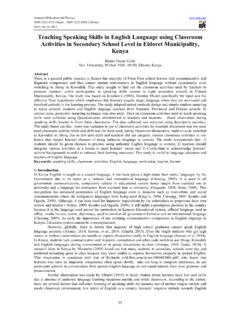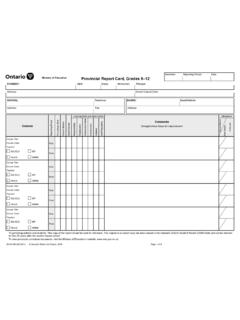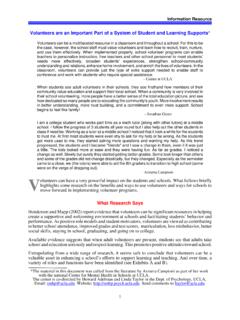Transcription of Internal and External Factors in Language Learning
1 International Journal of Modern Language Teaching and Learning Available online at Vol. 1, Issue 5, 2016, ISSN: 2367-9328 188 Internal and External Factors in Language Learning Nazanin Mirhadizadeh Department of english Language and literature, Ayatollah Amoli Branch, Islamic Azad University, Amol, Iran Email: Corresponding author s ABSTRACT Internal and External Factors are generally referred to the elements that exist inside and outside every individual. Internal Factors are dealt with those elements every individual brings with himself to the Learning context and these components are influenced by other Factors which persist in the environment that a learner lives. Not only environment affects the process of acquisition, but also the second/ foreign Language itself brings some other Factors into this complex process of Learning . This paper aims to mention some of the Factors which are under categorization of the Internal / External in second Language acquisition (SLA).
2 KEYWORDS: Internal Factors , External Factors , SLA INTRODUCTION Learning a second or foreign Language is not an easy matter to discuss, because it does not only require to know vocabulary and grammar of a Language being acquired, but also knowledge about the context and culture and a new way of thinking and acting needs a great consideration. The task of Learning a foreign Language is much more complex, since; you must have a comprehensive knowledge of the entry behavior of a person, and objectives you wish to reach of possible method (Brown, 2000, ). It is quite observable that some learners learn a new Language more quickly than others, because they are successful by their virtue of strong determination, hard work and persistence. Yet, some other learners are not very successful in acquiring a new Language , and it is quite obvious that there exist some crucial Factors affecting their success which are mostly beyond the learner s control.
3 Learning a second Language is a long and complex undertaking (Brown, 2007). Your whole person is affected as you struggle to reach beyond the confines of your fist Language into a new Language , new culture, new way of feeling and acting. Learning a Language is an emotional experience, and the feeling that the process of Learning evokes will have a crucial bearing on the success or failure on the Learning (Huchinson & waters, 1878, ). From this statement, it is clear that emotional Factors are important for learners to determine their success or failure in Learning a Language . To gain these emotional Factors students should be encouraged to learn a Language , to achieve success instead of failure. The second Language learner brings all these variables into the process of the leaning the second Language . Teacher also has to undertake the system and functioning of the Language that he teaches in order to enable students achieve it effectively.
4 As a matter of fact, researchers showed that children usually succeed in acquiring the spoken Language in early childhood provided that they have adequate opportunities to use languages over a period of several years (Brown & Spada, 2006). This is revers in case for the learner of second Language whose success is dependent on many Factors . Thus what remarked and observed several times in the same EFL classes is that some students show high interest in studying, by their well performance; therefore, they progress rapidly, while others make very slow progress, even if they learn in the very same conditions. However, there are crucial Factors relating to their success that are largely beyond the control of the learners participating in a class and a teacher as the facilitator and controller who is a great help to learners to achieve success in the process of Learning the second Language . There are many general Factors that influence second Language Learning such as age, aptitude, intelligence, cognitive style, attitudes, motivation, and personality (Ellis, 1994).
5 Considering all variables relating to second or foreign Language Learning simultaneously would be an extremely difficult task. Thus, it sounds logical to classify these Factors into two groups of Internal and External which include elements of the same type. External Factors are largely dealt with books dealing with curriculum development and course design and Internal Factors are discussed in SLA and psychology books. Internal variables imply cognitive and meta-cognitive Factors as intelligence, perception, self-esteem, Learning style etc. While External variables imply social and affective Factors such as social class, first Language , early start, L2 curriculum, etc. International Journal of Modern Language Teaching and Learning Available online at Vol. 1, Issue 5, 2016, ISSN: 2367-9328 189 Internal Factors They are Factors which come from inside the individual. According to Brown (2007), these Factors are specified by the individual students like motivation, attitude, personal practice and study habits.
6 Each of these Factors is an individual element of learners ability to acquire a foreign Language but each component also interacts with another. INTELLIGENCE. Intelligence is an issue that has been dealt with from many psychologists over many years till now. The term intelligence has traditionally been used to performance on certain kinds of tests. These tests are other associated with success in school (Brown and Spada, 2006, ). Nearly the same definition is provided by William and Burden, 1997 if asked to define what was meant by intelligence most people would probably refer to some form of inborn, general ability which enable some of us to better or faster than others . Oller, (cited in Brown, 2000, ) suggested that intelligence may after all be Language based. Language may not be merely a vital link in the social side of intellectual development; it may be the way foundation of intelligence itself . In relating intelligence to second Language Learning , we can say such a view tends to assume that intelligence is fixed at birth (Williams and Burden, 1997, ), that is, this perspective considers the success or failure in Learning english Language to intelligence.
7 If the student is logically smart, he will be able to succeed in Learning a second or foreign Language . These views of fixed intelligence dominated in the 1950. The famous proponents of this view were Carroll and Sapon in their work Carroll and Sapon s modern Language aptitude test of MLA (1950). MULTIPLE-INTELLIGENCE In recent years this perspective has changed, some researchers as Gardner (1985) argued that there are seven kinds of intelligence and that it should not be seen as a unitary. Visual spatial-intelligence: The learners who have this ability tend to perceive the world in images. They prefer to be taught through pictures, video, maps, charts, fact they create mental images in order to retain information. Verbal linguistic-intelligence: This type of learners tends to think in words rather than pictures. They have highly developed auditory skills and an extra ordinary ability to develop speech. Learners of such ability have a strong tendency to become fluent Language users.
8 Logical mathematical-intelligence: Learners with this ability have the reason to think in logical way. They have the capacity to connect pieces of information. Such learners have experiments and are always completely conscious and aware about everything about Learning . Bodily kinesthetic intelligence: They have the ability to use movements and gestures in order to learn they have a strong balance and a sense of coordination. They interact with the physical space and people around them and throughout this theory are able to process and retain information. Musical rhythmic intelligence: Learners this type, have the ability to produce and appreciate music. Such learners think in sounds, rhythms, and patterns. Interpersonal intelligence: Learners possessing this ability like interacting with others and have a strong capacity to understand the people around them. They always try to see how the others think and feel, and they try to create cooperative between group members and encourage communication.
9 Intrapersonal intelligence: These learners have a strong awareness of their inner state of being. They can understand their dreams, desires, relationship with the others, and furthermore their strengths and weakness. To sum up we can say that all individuals are born with a particular intelligence which determines how their future Learning styles would be like. The psychologist Robert Stemberg has also provided a helpful perspective, he argues that what may be intelligent behavior in one country might be viewed as unintelligent in another country. Others proposed triarchic theory of intelligence which contain three types of smartness: 1. Componential ability for analytical thinking. 2. Experimental ability to engage in creative thinking combining disparate experiences in insightful ways. 3. Contextual ability street smartness that enable people to play the game of manipulating their environment (others, institutions, situations, contexts). IMPACT OF INTELLIGENCE IN EDUCATION Intelligence is the role of cognitive skills within specific strategies and appropriate context which frees us from the old fixed view about intelligence, thus, the learner can improve himself.
10 In addition to the crucial role of the school in improving the students potential and intelligence, and the teacher also account encounters a great challenge in his task to help learners develop their strategies needed in Learning english Language and also give them the way of effective thinking as important aspect in education. International Journal of Modern Language Teaching and Learning Available online at Vol. 1, Issue 5, 2016, ISSN: 2367-9328 190 PERCEPTION In fact, perception is one of the most influential Factors that have a great impact on Learning . Like any other characteristic; perception differs from one individual to another. Before moving to the definition of the term perception, it is important to start with what William and Burden (1997, p. 26) said: Minds that have nothing to confer find little to perceive . Many researchers argued that perception is a very complex mental process and at the same time it is of a great help to the individual to interact with his External world.




